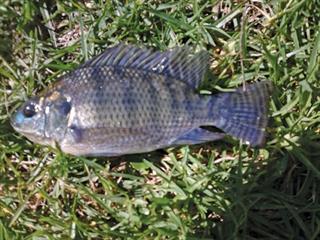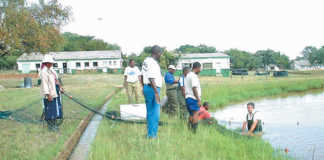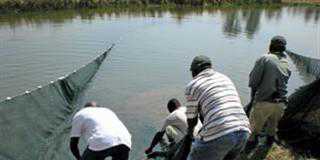
Which tilapia species is best for aquaculture? This is not as simple as it sounds; the answer depends on factors such as intended use, culture system and climatic and environmental conditions. The term ‘tilapia’ refers to all fish of the cichlid family that resemble the original genus Tilapia. In South Africa, naturally occurring tilapia fall into two genera: Oreochromis and Tilapia. Oreochromis are maternal mouth brooders, while Tilapia are substrate spawners. There are two indigenous species of each.
Oreochromis
- O. mossambicus: The Mozambique bream, or blue kurper, is the best-known tilapia species. It is deep-bodied and occurs in the warmer parts of South Africa in east-flowing rivers and dams. It has also been widely translocated to areas such as the Western Cape and Namibia. Red forms suitable for aquaculture are available. Its limitations include a temperature tolerance of above 12°C, relatively slow growth and early maturity.

Juvenile O. mossambicus has clear fins, while mature males have red edges on the fins.
- O. placidus: A similar but smaller species, O. placidus is found in the Mkuze swamps and the north-eastern lowlands extending into Mozambique. It has a different breeding colouration and four anal fin spines, compared with the three of O. mossambicus.
Tilapia
T. rendalli: The genus Tilapia is represented by T. rendalli and T. sparrmanii. The former, the well-known red breast tilapia, is restricted to water over 13°C in winter. Largely herbivorous, it is deep-bodied with a convex forehead profile. Females have red chests and up to nine vertical bands. Males have white chests. Red breast tilapia often have a distinct two-tone caudal fin colouration, red at the base and pale above, with no spotting. They are robust-bodied and will jump when surprised. This is the tastiest tilapia, but it grows slowly. The species is popular in aquaponics as it consumes plant waste.

A male T. rendalli in Burundi, showing the characteristic white breast, which is red in females.
T. sparrmanii
T. sparrmanii – vlei kurper or banded tilapia – is the most widespread species in South Africa. It is a good-looking fish, with a deep body and a blunt snout, but it is unsuitable for aquaculture as it does not grow longer than about 12cm. It is the most cold-tolerant of our indigenous tilapia and can survive at 6°C for short periods. It will live through the Highveld winter and have been widely trans-located through inter-basin river transfer schemes.

Non-native tilapia
The Nile tilapia (O. niloticus) has been introduced to South Africa for aquaculture as it has the potential to grow large and rapidly. But only the most carefully selected strains perform well; many inbred and stunted populations do poorly. The species is identified by the iridescent spots in the caudal fin. They readily hybridise with indigenous species.
Species such as O. andersoni (three-spot tilapia), O. aureus (Israeli tilapia) and O. macrochir (green-head tilapia) are non-native to South Africa, but have reportedly been introduced in certain places. O. andersonii has considerable aquaculture potential and is used in Zambia.
Nicholas James is an ichthyologist and hatchery owner.













